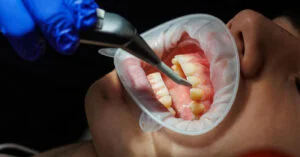
Related posts
What is Dental Fluorosis?
Dental Fluorosis is a condition that affects teeth, caused by excessive fluoride intake during the early years of tooth development. This condition primarily manifests through changes in the appearance of the tooth enamel. While fluoride is generally beneficial in preventing cavities, too much fluoride can lead to cosmetic issues that can be distressing for those affected.
Interestingly, dental Fluorosis is often first noticed by changes in the colour of the teeth, ranging from mild discolouration to more severe staining and surface irregularities. Although dental Fluorosis alters the appearance of the teeth, it typically doesn’t affect their function.
Dental Fluorosis Causes

The primary cause of dental Fluorosis is ingesting excessive fluoride during the years when teeth are forming. Fluoride is a mineral found in various sources, including drinking water, toothpaste, mouth rinses, and dietary supplements. While fluoride is beneficial in preventing tooth decay, overconsumption can lead to Fluorosis. Some common causes include:
Fluoridated Drinking Water: Children at a higher risk of developing dental Fluorosis live in areas with high fluoride levels in drinking water.
Excessive Use of Fluoridated Dental Products: Young children who use fluoride toothpaste or mouth rinses and tend to swallow these products instead of spitting them out are likelier to ingest excessive fluoride.
Fluoride Supplements: Inappropriate use of fluoride supplements, especially in regions where the water is already fluoridated, can contribute to an excessive fluoride intake.
Dietary Sources: Foods and beverages processed with fluoridated water can also increase fluoride intake.
Dental Fluorosis Symptoms
The symptoms of dental Fluorosis vary depending on the severity of the condition. The degree of Fluorosis is often categorized as mild, moderate, or severe, with corresponding symptoms:
- Mild Fluorosis: This is the most common form and often goes unnoticed. It appears as faint white streaks or patches on the tooth enamel. These changes are usually so subtle that only a dentist can detect them during a routine checkup.
- Moderate Fluorosis: In this case, the white patches become more pronounced and may cover larger tooth surface areas. There might also be slight brown discolouration.
- Severe Fluorosis: This is the least common form, characterized by extensive brown staining and visible pitting of the tooth enamel. The teeth may also appear discoloured and develop an uneven surface.

Dental Fluorosis Treatment Options
While dental Fluorosis is not harmful to dental health, the aesthetic concerns it raises can be significant. Various treatment options are available to improve the appearance of teeth affected by Fluorosis:
Teeth Whitening: Professional teeth whitening can help lighten the stains and improve the overall appearance of mildly fluorosed teeth. However, it may not be effective for severe cases.
Microabrasion: This procedure involves removing a thin layer of enamel to reduce the appearance of stains. It is usually adequate for mild to moderate Fluorosis.
Bonding: Dental bonding involves applying a tooth-coloured resin to the surface of the affected teeth to cover the stains and improve aesthetics.
Veneers: Porcelain or composite veneers are custom-made shells that cover the teeth’ front surface. They provide a natural appearance and hide the discolouration caused by Fluorosis. Veneers are particularly effective for moderate to severe cases.
Crowns: In severe cases where the enamel is significantly damaged, dental crowns can restore the teeth’s appearance and function.

Preventing Dental Fluorosis
Prevention is vital when it comes to dental Fluorosis. Parents and caregivers can take several steps to reduce the risk of their children developing this condition:
Monitor Fluoride Intake: Ensure that children use an appropriate amount of fluoride toothpaste (a pea-sized amount) and teach them to spit it out after brushing.
Check Water Fluoride Levels: Be aware of the fluoride levels in the local drinking water. If necessary, use a water filter that removes excess fluoride.
Avoid Fluoride Supplements Unless Necessary: Consult with a dentist or paediatrician before giving children fluoride supplements, especially if they already receive fluoride from other sources.
Encourage Healthy Dental Habits: Promote good dental hygiene practices and regular dental checkups to ensure early detection and management of any dental issues.
Conclusion
Dental Fluorosis is a common condition that primarily affects the appearance of teeth due to excessive fluoride exposure during childhood. Understanding its causes, symptoms, and treatment options can help manage and prevent this condition. While dental Fluorosis is not harmful to oral health, addressing aesthetic concerns through various treatments can significantly improve one’s confidence and smile. Regular dental visits and mindful fluoride use are essential to ensure healthy, beautiful teeth for a lifetime. Visit our advanced dental care facility in Bangalore for expert treatment of dental fluorosis and more. Schedule your consultation today